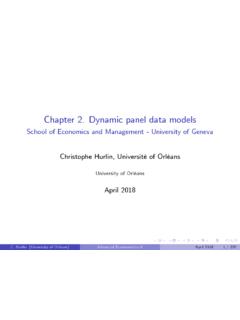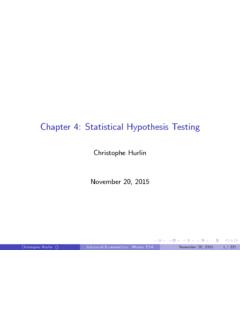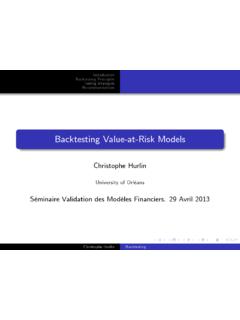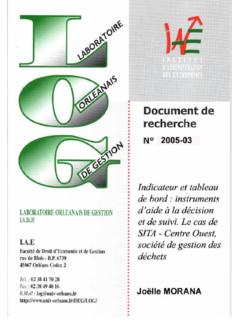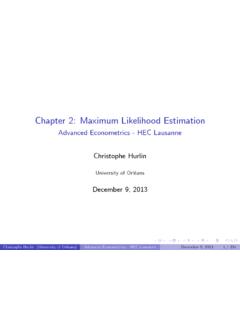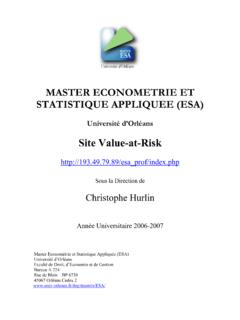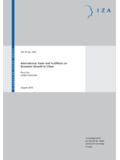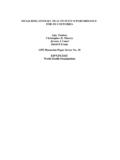Transcription of Advanced Econometrics II - Accueil
1 Advanced Econometrics II. School of Economics and Management - University of Geneva Christophe Hurlin, Universit d'Orl ans University of Orl ans February 2018. C. Hurlin (University of Orl ans) Advanced Econometrics II February 2018 1 / 61. Introduction " Econometrics is the quantitative analysis of actual economic phenomena based on the concurrent development of theory and observation, related by appropriate methods of inference", P. A. Samuelson, T. C. Koopmans, and J. R. N. Stone (1954). C. Hurlin (University of Orl ans) Advanced Econometrics II February 2018 2 / 61. Introduction Econometrics is fundamentally based on four elements: 1 A sample of data 2 An econometric model 3 An estimation method 4 Some inference methods C. Hurlin (University of Orl ans) Advanced Econometrics II February 2018 3 / 61. Introduction In Econometrics , data come from one of the two sources: experiments and non-experimental observations 1 Experimental data are based on (randomized controlled).
2 Experiments designed to evaluate a treatment or policy or to investigate a causal e ect. 2 data obtained outside an experimental setting are called observational data (issued from survey, administrative records ). All of this lecture is devoted to methods for handling real-world observational data C. Hurlin (University of Orl ans) Advanced Econometrics II February 2018 4 / 61. Introduction Whether the data is experimental or observational, data sets can be mainly distinguished in three types: 1 Cross-sectional data 2 Time series data 3 Panel data C. Hurlin (University of Orl ans) Advanced Econometrics II February 2018 5 / 61. Introduction Cross-sectional data : data for di erent entities: workers, households, rms, cities, countries, and so forth. No time dimension (even if date of data collection varies somewhat across units, it is ignored).
3 Order of data does not matter! C. Hurlin (University of Orl ans) Advanced Econometrics II February 2018 6 / 61. Introduction Time series data : data for a single entity (person, rm, country) collected at multiple time periods. Repeated observations of the same variables (GDP, prices). Order of data is important! Observations are typically not independent over time;. In this case the notion of population corresponds to the data Generating Process (DGP). C. Hurlin (University of Orl ans) Advanced Econometrics II February 2018 7 / 61. Introduction Panel data or longitudinal data : data for multiple entities (individuals, rms, countries) in which outcomes and characteristics of each entity are observed at multiple points in time. Combine cross-sectional and time series issues. Present several advantages with respect to cross-sectional and time series data (depending on the question of interest!)
4 C. Hurlin (University of Orl ans) Advanced Econometrics II February 2018 8 / 61. Introduction Objectives of the course The objectives of the course are the following: 1 to understand the speci cation, estimation, and inference in the context of models that include individual ( rm, person, etc.) and/or time e ects. 2 to review the standard linear regression model, then to apply it to panel data settings involving ' xed', 'random', and 'mixed'e ects. 3 to extend this linear panel data models to dynamic models with recently developed GMM and instrumental variables methods. 4 to extend this linear panel data models to non-linear panel data models C. Hurlin (University of Orl ans) Advanced Econometrics II February 2018 9 / 61. Section 2. Baseline De nitions C. Hurlin (University of Orl ans) Advanced Econometrics II February 2018 10 / 61.
5 De nitions De nition (Panel data set). A longitudinal, or panel, data set is one that follows a given sample of individuals over time, and thus provides multiple observations on each individual in the sample (Hsiao 2003, page 2). C. Hurlin (University of Orl ans) Advanced Econometrics II February 2018 11 / 61. De nitions Terminology and notations: Individual or cross section unit : country, region, state, rm, consumer, individual, couple of individuals or countries (gravity models), etc. Double index : i (for cross-section unit) and t (for time). yit for i = 1, .., N and t = 1, .., T. C. Hurlin (University of Orl ans) Advanced Econometrics II February 2018 12 / 61. De nitions De nition (micro-panel). A micro-panel data set is a panel for which the time dimension T is largely less important than the individual dimension N: T << N. Example (micro-panel).
6 The University of Michigan's Panel Study of Income Dynamics, PSID with 15,000 individuals observed since 1968 is a micro-panel. C. Hurlin (University of Orl ans) Advanced Econometrics II February 2018 13 / 61. De nitions De nition (macro-panel). A macro-panel data set is a panel for which the time dimension T is similar to the individual dimension N : T 'N. Example (macro-panel). A panel of 100 countries with quaterly data since the WW2 is considered as a macro-panel. C. Hurlin (University of Orl ans) Advanced Econometrics II February 2018 14 / 61. De nitions Remark: some econometric issues are speci c to micro or macro panels . Example (heterogeneity issue). The heterogeneity issue cannot be tackled with if the time dimension is too small. Example (non stationarity issue). The non-stationarity issue (non-stationarity and cointegration tests, VECM, etc.)
7 Is only relevant for macro-panel or for panel with a time dimension su ciently large. C. Hurlin (University of Orl ans) Advanced Econometrics II February 2018 15 / 61. De nitions De nition (balanced vs. unbalanced panels ). A panel is said to be balanced if we have the same time periods, t = 1, .., T , for each cross section observation. For an unbalanced panel, the time dimension, denoted Ti , is speci c to each individual. C. Hurlin (University of Orl ans) Advanced Econometrics II February 2018 16 / 61. Introduction Balanced panel with T = 11. and N = 3. C. Hurlin (University of Orl ans) Advanced Econometrics II February 2018 17 / 61. Introduction Balanced panel with missing values C. Hurlin (University of Orl ans) Advanced Econometrics II February 2018 18 / 61. Introduction Unbalanced panel with T = 11 and N = 3. C. Hurlin (University of Orl ans) Advanced Econometrics II February 2018 19 / 61.
8 De nitions Remark: While the mechanics of the unbalanced case are similar to the balanced case, a careful treatment of the unbalanced case requires a formal description of why the panel may be unbalanced, and the sample selection issues can be somewhat subtle. => issues of sample selection and attrition C. Hurlin (University of Orl ans) Advanced Econometrics II February 2018 20 / 61. De nitions De nition (Panel data model). A panel data regression model (or panel data model) is an econometric model speci cally designed for panel data . C. Hurlin (University of Orl ans) Advanced Econometrics II February 2018 21 / 61. Section 3. Advantages of Panel data Sets and Panel data Models C. Hurlin (University of Orl ans) Advanced Econometrics II February 2018 22 / 61. Advantages of Panel data Panel data sets for economic research possess several major advantages over conventional cross-sectional or time-series data sets.
9 Hsiao, C., (2003, 2nd ed), Analysis of Panel data , second edition, Cambridge University Press. Wooldridge , (2001), Econometric Analysis of Cross Section and Panel data , The MIT Press. C. Hurlin (University of Orl ans) Advanced Econometrics II February 2018 23 / 61. Advantages of Panel data What are the main advantages of the panel data sets and the panel data models? Advantage 1: the phantasm of a larger number of observations Advantage 2: new economic questions (identi cation). Advantage 3: unobservable components Advantage 4: easier estimation and inference C. Hurlin (University of Orl ans) Advanced Econometrics II February 2018 24 / 61. Advantages of Panel data Advantage 1: the phantasm of a larger number of observations Panel data usually give the researcher a large number of data points (N T ), increasing the degrees of freedom and reducing the collinearity among explanatory variables hence improving the e ciency of econometric estimates But it is often of more data points doesn't necessarily imply more information => heterogeneity issue !
10 ! C. Hurlin (University of Orl ans) Advanced Econometrics II February 2018 25 / 61. Advantages of Panel data Advantage 2: new economic questions (identi cation). Longitudinal data allow a researcher to analyze a number of important economic questions that cannot be addressed using cross-sectional or time-series data sets. C. Hurlin (University of Orl ans) Advanced Econometrics II February 2018 26 / 61. Advantages of Panel data De nition (identi cation). The oft-touted power of panel data derives from their theoretical ability to identify the e ects of speci c actions, treatments, or more general policies. C. Hurlin (University of Orl ans) Advanced Econometrics II February 2018 27 / 61. Advantages of Panel data Example (Ben-Porath (1973), cited in Hsiao (2003)). Suppose that a cross-sectional sample of married women is found to have an average yearly labor-force participation rate of 50%.
